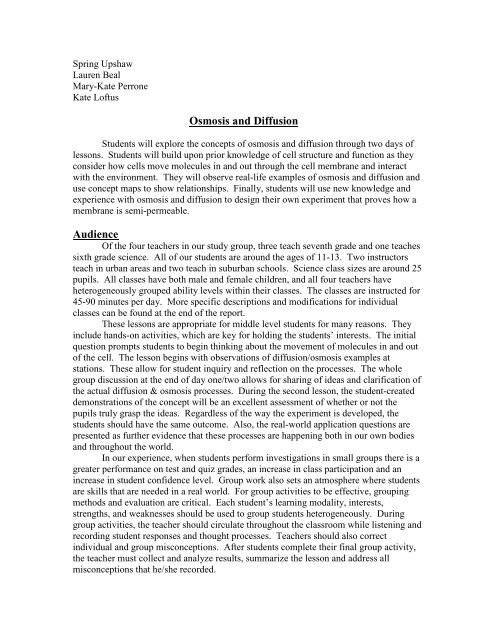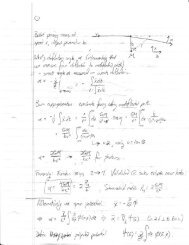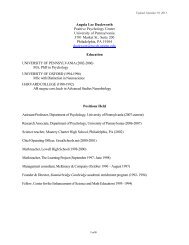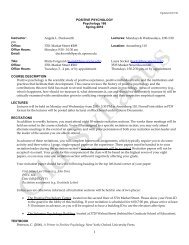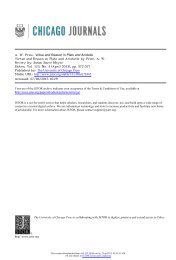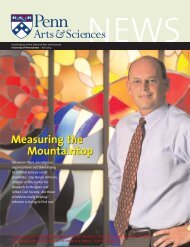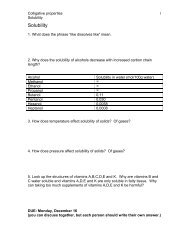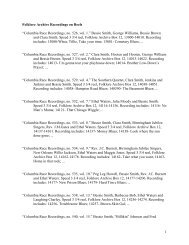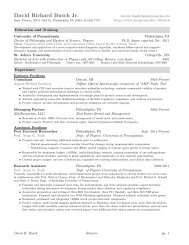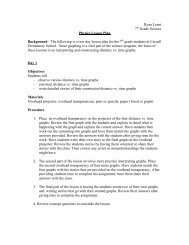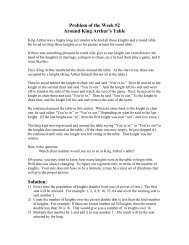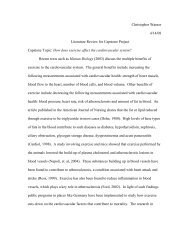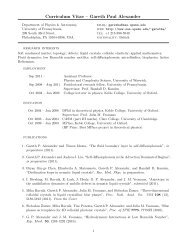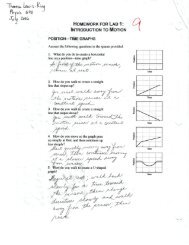Osmosis and Diffusion Audience - School of Arts & Sciences
Osmosis and Diffusion Audience - School of Arts & Sciences
Osmosis and Diffusion Audience - School of Arts & Sciences
Create successful ePaper yourself
Turn your PDF publications into a flip-book with our unique Google optimized e-Paper software.
Spring Upshaw<br />
Lauren Beal<br />
Mary-Kate Perrone<br />
Kate L<strong>of</strong>tus<br />
<strong>Osmosis</strong> <strong>and</strong> <strong>Diffusion</strong><br />
Students will explore the concepts <strong>of</strong> osmosis <strong>and</strong> diffusion through two days <strong>of</strong><br />
lessons. Students will build upon prior knowledge <strong>of</strong> cell structure <strong>and</strong> function as they<br />
consider how cells move molecules in <strong>and</strong> out through the cell membrane <strong>and</strong> interact<br />
with the environment. They will observe real-life examples <strong>of</strong> osmosis <strong>and</strong> diffusion <strong>and</strong><br />
use concept maps to show relationships. Finally, students will use new knowledge <strong>and</strong><br />
experience with osmosis <strong>and</strong> diffusion to design their own experiment that proves how a<br />
membrane is semi-permeable.<br />
<strong>Audience</strong><br />
Of the four teachers in our study group, three teach seventh grade <strong>and</strong> one teaches<br />
sixth grade science. All <strong>of</strong> our students are around the ages <strong>of</strong> 11-13. Two instructors<br />
teach in urban areas <strong>and</strong> two teach in suburban schools. Science class sizes are around 25<br />
pupils. All classes have both male <strong>and</strong> female children, <strong>and</strong> all four teachers have<br />
heterogeneously grouped ability levels within their classes. The classes are instructed for<br />
45-90 minutes per day. More specific descriptions <strong>and</strong> modifications for individual<br />
classes can be found at the end <strong>of</strong> the report.<br />
These lessons are appropriate for middle level students for many reasons. They<br />
include h<strong>and</strong>s-on activities, which are key for holding the students’ interests. The initial<br />
question prompts students to begin thinking about the movement <strong>of</strong> molecules in <strong>and</strong> out<br />
<strong>of</strong> the cell. The lesson begins with observations <strong>of</strong> diffusion/osmosis examples at<br />
stations. These allow for student inquiry <strong>and</strong> reflection on the processes. The whole<br />
group discussion at the end <strong>of</strong> day one/two allows for sharing <strong>of</strong> ideas <strong>and</strong> clarification <strong>of</strong><br />
the actual diffusion & osmosis processes. During the second lesson, the student-created<br />
demonstrations <strong>of</strong> the concept will be an excellent assessment <strong>of</strong> whether or not the<br />
pupils truly grasp the ideas. Regardless <strong>of</strong> the way the experiment is developed, the<br />
students should have the same outcome. Also, the real-world application questions are<br />
presented as further evidence that these processes are happening both in our own bodies<br />
<strong>and</strong> throughout the world.<br />
In our experience, when students perform investigations in small groups there is a<br />
greater performance on test <strong>and</strong> quiz grades, an increase in class participation <strong>and</strong> an<br />
increase in student confidence level. Group work also sets an atmosphere where students<br />
are skills that are needed in a real world. For group activities to be effective, grouping<br />
methods <strong>and</strong> evaluation are critical. Each student’s learning modality, interests,<br />
strengths, <strong>and</strong> weaknesses should be used to group students heterogeneously. During<br />
group activities, the teacher should circulate throughout the classroom while listening <strong>and</strong><br />
recording student responses <strong>and</strong> thought processes. Teachers should also correct<br />
individual <strong>and</strong> group misconceptions. After students complete their final group activity,<br />
the teacher must collect <strong>and</strong> analyze results, summarize the lesson <strong>and</strong> address all<br />
misconceptions that he/she recorded.
Enduring Underst<strong>and</strong>ing:<br />
We can underst<strong>and</strong> biological phenomena by analyzing them at multiple levels.<br />
Big Ideas:<br />
1. Molecules move into <strong>and</strong> out <strong>of</strong> cells along a concentration gradient<br />
2. Cells have semi-permeable boundaries<br />
3. Molecules are constantly in motion<br />
4. The concentration <strong>of</strong> cells change with their changing environment<br />
Importance: You are what you eat.<br />
Essential Questions:<br />
1. Why do we say, “You are what you eat?”<br />
2. Why do cells transport molecules in <strong>and</strong> out <strong>of</strong> their membranes?<br />
3. How do cells adapt to their environments?<br />
What students will need to know <strong>and</strong> be able to do<br />
(knowledge <strong>and</strong> skills):<br />
1. Design an experiment proving membranes can be selectively permeable.<br />
2. Explain the process <strong>of</strong> diffusion.<br />
3. Describe how osmosis occurs.<br />
4. Compare <strong>and</strong> contrast diffusion <strong>and</strong> osmosis.<br />
5. Identify a concentration gradient <strong>and</strong> its relationship to transport.<br />
What do students typically misunderst<strong>and</strong>?<br />
Our combined experiences teaching life science has shown these topics to be<br />
difficult for sixth <strong>and</strong> seventh graders. Research also shows common student<br />
misconceptions in these areas. In particular, students have trouble underst<strong>and</strong>ing that<br />
cells – like multi-cellular organisms – live in an environment <strong>and</strong> must perform all<br />
activities necessary to stay alive. Common student misconceptions also include<br />
confusion about the difference between cells <strong>and</strong> molecules <strong>and</strong> the size difference<br />
between proteins, molecules <strong>and</strong> cells (Holt 2005).<br />
A 2003 study on addressing student misconceptions – specifically osmosis <strong>and</strong><br />
diffusion – showed significant change when students were instructed through concept<br />
mapping <strong>and</strong> conceptual change text (Tekkaya 2003). The study was developed to<br />
promote meaningful learning in order to address misunderst<strong>and</strong>ings about diffusion <strong>and</strong><br />
osmosis. Several <strong>of</strong> the fallacies found by Tekkaya are addressed within the teacher<br />
notes <strong>of</strong> our lesson. The study found that many misconceptions held by students were<br />
resistant to change by traditional teaching practices, such as textbook readings <strong>and</strong> direct<br />
instruction with minimal student involvement. When allowed to explore their own ideas<br />
<strong>and</strong> work in collaborative groups, students were found to be more successful in<br />
recognizing their false impressions <strong>and</strong> accepting scientific reasons. Tekkaya used two<br />
groups <strong>of</strong> students to evaluate whether traditional methods or inquiry methods were more<br />
effective in leading to a conceptual change. The final result showed a significant<br />
difference; the number <strong>of</strong> experimental group students holding a scientifically correct
view rose 31.6%, compared to a 19.6% gain for students taught with traditional methods<br />
(Tekkaya).<br />
This study reinforces our decision to use a variety <strong>of</strong> strategies to address student<br />
misconceptions <strong>and</strong> ensure meaningful underst<strong>and</strong>ing. Through these two lessons,<br />
students will be introduced to topics with questions aimed at revealing false impressions.<br />
The activities are designed to enhance content, make real life connections <strong>and</strong> elicit<br />
critical thinking, which in turn will lead to deeper content knowledge about passive<br />
transport. More specifically, we will use concept-mapping strategies, as suggested in<br />
Tekkaya’s article, to help students make connections <strong>and</strong> “see” relationships between<br />
different cell processes as well as within the levels <strong>of</strong> organization.<br />
Student Prior Knowledge:<br />
Students will learn osmosis <strong>and</strong> diffusion after studying cell structure <strong>and</strong><br />
function. Before these lessons, it is assumed that students will have the following prior<br />
knowledge:<br />
• Cell structure <strong>and</strong> function<br />
• Molecules are always in motion<br />
• Cell permeability<br />
• Cells turn food into chemicals for energy<br />
• Cells store <strong>and</strong> use energy for building materials, transport <strong>and</strong> controlling<br />
life processes<br />
• Cells need chemical compounds to perform functions <strong>and</strong> build structures<br />
St<strong>and</strong>ards:<br />
National St<strong>and</strong>ards<br />
Content St<strong>and</strong>ard A: Science as Inquiry<br />
• Ability necessary to do scientific inquiry<br />
• Underst<strong>and</strong>ings about scientific inquiry<br />
New Jersey St<strong>and</strong>ards<br />
5.1 All students will develop problem solving, decision making <strong>and</strong> inquiry<br />
skills, reflected by formulating usable questions <strong>and</strong> hypotheses, planning<br />
experiments, conducting systemic observations, interpreting <strong>and</strong> analyzing<br />
data, drawing conclusions <strong>and</strong> communicating results.<br />
5.5 All students will gain an underst<strong>and</strong>ing <strong>of</strong> the structure, characteristics <strong>and</strong><br />
basic needs <strong>of</strong> organisms <strong>and</strong> will investigate the diversity <strong>of</strong> life.<br />
Pennsylvania St<strong>and</strong>ards<br />
3.3.7A - Describe the similarities <strong>and</strong> differences that characterize diverse living<br />
things.<br />
3.3.7B - Describe the cell as the basic structural <strong>and</strong> functional unit <strong>of</strong> living<br />
things.<br />
3.2.7A – Explain <strong>and</strong> apply scientific <strong>and</strong> technological knowledge.
3.2.7B - Apply process knowledge to make <strong>and</strong> interpret observations.<br />
3.2.7C – Identify <strong>and</strong> use the elements <strong>of</strong> science inquiry to solve problems.<br />
Content<br />
One characteristic that scientists use to identify organisms is the presence <strong>of</strong> cells.<br />
Some organisms are unicellular (having one cell), <strong>and</strong> others are multi-cellular (having<br />
many cells). The structures in cells vary depending on the cell’s function. One structure<br />
common among all cells is the cell membrane. The cell membrane forms a boundary <strong>of</strong><br />
most cells <strong>and</strong> regulates what enters <strong>and</strong> exits the cell. It is made <strong>of</strong> a phospholipid bilayer<br />
that makes it semi-permeable. Within the cell membrane are proteins <strong>and</strong><br />
carbohydrates that also control what is able to enter <strong>and</strong> exit the cell.<br />
Inside the cell is cytosol, which is composed <strong>of</strong> mostly water, as well as other<br />
compounds such as salts, proteins <strong>and</strong> carbohydrates. The materials inside <strong>of</strong> the cell<br />
contribute to a concentration gradient between the cell <strong>and</strong> its environment. To maintain<br />
equilibrium (constant concentration inside <strong>and</strong> outside <strong>of</strong> the cell), molecules constantly<br />
cross the cell membrane. Small molecules such as water, oxygen <strong>and</strong> carbon dioxide<br />
move across the cell membrane without using energy. Factors that contribute to the<br />
movement <strong>of</strong> these molecules include unequal concentrations inside <strong>and</strong> out <strong>of</strong> the cell<br />
<strong>and</strong> the constant movement <strong>of</strong> molecules. If there is a higher concentration <strong>of</strong> water on<br />
one side <strong>of</strong> the cell, the water molecules will collide <strong>and</strong> move across the membrane in<br />
the direction <strong>of</strong> the lower concentration <strong>of</strong> water. This process is called osmosis.<br />
<strong>Osmosis</strong> will continue until the cell reaches a state <strong>of</strong> equilibrium. Because molecules<br />
are constantly in motion, the water continues to cross the membrane but does not result in<br />
a change <strong>of</strong> concentration. Molecules such as oxygen <strong>and</strong> carbon dioxide behave in the<br />
same manner as water, but the process is known as diffusion.<br />
Teaching Method(s), Instructional Procedures, <strong>and</strong> Learning Activities:<br />
Day One/Two<br />
(Teacher might choose to teach this lesson over two days to allow for proper<br />
implementation given time constraints).<br />
Objective: Students will be able to observe <strong>and</strong> compare the effects <strong>of</strong> diffusion <strong>and</strong><br />
osmosis.<br />
Anticipatory Set: Teacher will check for prior knowledge <strong>of</strong> diffusion <strong>and</strong> osmosis by<br />
having students complete the following questions on an activity sheet:<br />
Teacher Note: The activity sheet will be given for the anticipatory set to allow students to<br />
visualize the concepts as they are processing an answer. It will also allow the teacher to<br />
evaluate the student’s thought process. Students have already studied the structure <strong>and</strong>
function <strong>of</strong> cells. They have been told that the cell membrane is semi-permeable <strong>and</strong> are<br />
able to define “semi-permeability.”<br />
1. (picture <strong>of</strong> balloon with 20 drops <strong>of</strong> vanilla inside it) Will you be able to smell the<br />
vanilla that is inside the balloon? Why or why not?<br />
a. Teacher Note: Can the students apply the concept <strong>of</strong> permeability? Do<br />
students believe that a balloon can be semi-permeable? Do they believe<br />
that its semi-permeability will allow them to smell the vanilla through the<br />
balloon?<br />
2. (picture <strong>of</strong> air freshener with spray coming out <strong>of</strong> it) If freshener is sprayed in the<br />
front <strong>of</strong> the classroom, will the students in the back be able to smell it?<br />
a. Teacher note: Do the students believe that molecules are constantly in<br />
motion? Do students believe that molecules want to spread out? Are<br />
students aware <strong>of</strong> the movement <strong>of</strong> molecules from a high to low<br />
concentration?<br />
3. (picture <strong>of</strong> beaker <strong>of</strong> cold water, <strong>and</strong> one <strong>of</strong> hot water) If you add food coloring to<br />
both <strong>of</strong> these beakers at the same time, what will happen? Why?<br />
a. Teacher note: Do students believe that molecules are constantly in<br />
motion? Do students believe that temperature influences the speed at<br />
which molecules move? This question aims at another misunderst<strong>and</strong>ing<br />
highlighted by Tekkaya’s study. Students had to identify the process that<br />
caused a drop <strong>of</strong> blue dye to spread throughout a beaker <strong>of</strong> clear water.<br />
Students overwhelmingly answered incorrectly; they explained “the<br />
process responsible … because the dye separates into smaller particles <strong>and</strong><br />
mixes with water” (2003). Students were not aware that molecules are<br />
constantly in motion, causing the dye to diffuse.<br />
Instructional Input:<br />
1. Review cell membrane permeability.<br />
2. Introduce osmosis <strong>and</strong> diffusion by demonstrating scenarios presented in the<br />
Anticipatory Set, <strong>and</strong> reviewing the answers.<br />
Guided Practice:<br />
Teacher Note: This demonstration addresses a misconception highlighted in<br />
Tekkaya’s study. Students showed difficulty with the idea <strong>of</strong> a concentration gradient;<br />
they believed that diffusion was dependent upon space available within an area, rather<br />
than unequal concentration levels <strong>and</strong> constant r<strong>and</strong>om motion <strong>of</strong> molecules (Tekkaya<br />
2003).<br />
1. Teacher will introduce the concept <strong>of</strong> concentration gradient using a stalk <strong>of</strong><br />
celery in fresh water versus one in salt water.<br />
a. Celery in salt water: teacher will review the fact that cell’s cytoplasm is<br />
composed <strong>of</strong> a great amount <strong>of</strong> water. There is a greater percentage <strong>of</strong><br />
water inside <strong>of</strong> cells than in the salt water surrounding the cells. This<br />
unequal amount <strong>of</strong> water inside <strong>and</strong> outside <strong>of</strong> the cell creates a<br />
concentration gradient. The cell wants to be in balance with its<br />
environment, so water will leave the cell. Water will leave rather than salt
entering because it is small enough to pass through the membrane. The<br />
salt is too large to pass through the membrane.<br />
b. Celery in plain water: The cell is not only made up <strong>of</strong> water, there are also<br />
salts, sugars <strong>and</strong> proteins. Because there is only water in the beaker, there<br />
is a greater water concentration in the beaker than the cells <strong>of</strong> the celery.<br />
This creates a concentration gradient, <strong>and</strong> to reach a balance, water enters<br />
the cells. As stated previously, water moves because it can freely pass<br />
through the cell membrane. The other molecules are too large.<br />
2. Teacher <strong>and</strong> students will discuss differences between the amount <strong>of</strong> water inside<br />
<strong>and</strong> outside <strong>of</strong> the cells <strong>and</strong> its effects on the size <strong>of</strong> the celery cells.<br />
3. Teacher <strong>and</strong> students will discuss the impact <strong>of</strong> the environment on the<br />
concentration <strong>of</strong> molecules in cells.<br />
4. Teacher will set up two sets <strong>of</strong> each <strong>of</strong> the three stations. Students will be<br />
assigned to groups <strong>of</strong> 4 members. Directions will be given for the independent<br />
practice.<br />
Independent Practice:<br />
Have 2 sets <strong>of</strong> the three stations set-up at tables. Groups <strong>of</strong> students should be around 4<br />
members.<br />
Station 1<br />
Setup - pieces <strong>of</strong> potato in cups <strong>of</strong> regular water <strong>and</strong> in salt water<br />
Question for Students to Answer:<br />
1. Describe the flexibility <strong>of</strong> each <strong>of</strong> the potato slices.<br />
2. What types <strong>of</strong> macromolecules would you find in a potato?<br />
3. What is causing the difference in flexibility in each potato?<br />
Teacher note: Students will see the difference in concentration gradients between the<br />
three samples. Students will see that the potato in salt water will become limp because<br />
the water moves out <strong>of</strong> the cells via osmosis. The one in fresh water will become hard<br />
<strong>and</strong> have minimal flexibility because water will move into the cells.<br />
Station 2<br />
Set-up – picture <strong>of</strong> normal slug & one <strong>of</strong> slug covered in salt<br />
Questions for students to answer:<br />
1. Using the picture or past experience, what happens to a slug when salt is put on<br />
it?<br />
2. Knowing that a slug is a living thing, what molecule makes up most <strong>of</strong> the slugs’<br />
cells?<br />
3. What is causing the appearance <strong>of</strong> the salted slug?<br />
Teacher note: The water in the salted slug’s cells moves out <strong>of</strong> the cell through osmosis.<br />
Be sure to clarify that the slug is not “burning,” <strong>and</strong> describe why the slug dies.
Station 3<br />
Set-up – microscope with Elodea in fresh water slide<br />
Questions for students to answer:<br />
1. After viewing the slide, draw a picture <strong>of</strong> what the Elodea cells would look like<br />
after being placed in salt water.<br />
2. Draw an arrow showing what happens to the water contained inside the Elodea<br />
cell.<br />
Teacher note: For #1, students will observe that cell membrane is close to the cell wall<br />
<strong>and</strong> chloroplasts are spread throughout the cell. In #2, students will draw arrows pointing<br />
out <strong>of</strong> the cell to show movement <strong>of</strong> water by the process <strong>of</strong> osmosis. Show an actual<br />
slide <strong>of</strong> Elodea in salt water at the end as pro<strong>of</strong> <strong>of</strong> osmosis.<br />
Group Discussion: Students will reconvene as a whole group after visiting all three<br />
stations. Students will be given a concept map (attached) to complete individually. This<br />
concept map allows the teacher to check for misconceptions regarding the relationship<br />
between diffusion <strong>and</strong> osmosis. It will also be used as a way for students to see the<br />
connection between the scientific concepts <strong>and</strong> specific examples from class. As noted in<br />
Tekkaya, “concept mapping … can result in better underst<strong>and</strong>ing <strong>of</strong> diffusion <strong>and</strong><br />
osmosis through differentation, exchange <strong>and</strong> integration <strong>of</strong> new conceptions into<br />
existing ones” (2003). The teacher will facilitate a discussion based on the answers,<br />
using the LCD projector to show the final correct concept map.<br />
(See teacher notes above for detailed answers)<br />
Homework question:<br />
Ingrid had a birthday <strong>and</strong> was able to choose a pet. The pet that she chose was a beautiful<br />
clownfish named NancyLee, a common salt water fish. Ingrid already has a tank with<br />
goldfish at home. Use your knowledge <strong>of</strong> diffusion <strong>and</strong> osmosis to tell Ingrid how to take<br />
care <strong>of</strong> NancyLee.<br />
Day Three/Four<br />
(Teacher might choose to teach this lesson over two days to allow for proper<br />
implementation given time constraints. On the first day, students will be given<br />
instructions <strong>and</strong> be required to write a hypothesis <strong>and</strong> a set <strong>of</strong> procedures. On the second<br />
day, students will set up their experiment <strong>and</strong> make observations).<br />
Objective: Students will be able to design an experiment proving that membranes can be<br />
selectively permeable.<br />
Materials (per group): 20 cm piece <strong>of</strong> dialysis tubing, 100 mL starch solution, 10 mL<br />
iodine solution, beakers, water, two pieces <strong>of</strong> string (10 cm long)<br />
Anticipatory Set:<br />
Teacher will review homework question regarding clownfish.
Answer: Goldfish are freshwater fish, while NancyLee (the beautiful clownfish) is<br />
a saltwater fish. Ingrid must put NancyLee in a separate tank with saltwater. If NancyLee<br />
is placed in the freshwater, she will exp<strong>and</strong> due to the difference in concentration<br />
between NancyLee <strong>and</strong> the environment. This will kill NancyLee <strong>and</strong> upset Ingrid.<br />
Teacher will review diffusion by showing students a cube containing pieces that represent<br />
a membrane, iodine <strong>and</strong> starch. Students will answer the question, “What is larger, starch<br />
or iodine? How do you know?”<br />
(Students will be expected to know the answer based on prior lessons on<br />
molecules, compounds <strong>and</strong> elements)<br />
Guided Practice:<br />
Students will be assigned to groups <strong>of</strong> 2 or 3.<br />
Teacher <strong>and</strong> students will discuss the answers to the questions from the anticipatory set.<br />
Teachers will instruct students to design an experiment, using the materials, to prove that<br />
membranes can be selectively permeable.<br />
Independent Practice:<br />
Students work in groups to design an experiment. The procedure must be written <strong>and</strong><br />
checked by the teacher before setting up the experiment.<br />
Students perform their experiment <strong>and</strong> complete a written lab report. In their observation<br />
sections, students will be required to sketch their initial <strong>and</strong> final set-up <strong>and</strong> use arrows<br />
<strong>and</strong> labels to show what process is occurring.<br />
Closure (by the end <strong>of</strong> second day <strong>of</strong> lesson):<br />
Students will report findings to class.<br />
Teacher will facilitate discussion about different methods with which students carried out<br />
their experiments.<br />
Students will use dry erase boards to answer the following question:<br />
“You have a dialysis bag filled with starch solution. The bag is placed in iodine. Will you<br />
observe diffusion? Will you observe osmosis? Draw a picture <strong>of</strong> the process that will take<br />
place.”<br />
Answer: You will observe diffusion as the size <strong>of</strong> iodine allows it to enter through the<br />
semi-permeable dialysis bag into the starch solution. We know the iodine enters because<br />
the iodine turns from purple to black, as it reacts with the starch. This is not an example<br />
<strong>of</strong> osmosis, because iodine is being transported, not water.<br />
Teacher Note: Students’ pictures should illustrate the answer given above.<br />
Assessments:<br />
Written lab reports<br />
Student dry erase diagrams<br />
* Several general rubrics are attached to this lesson plan. These rubrics should be<br />
used as a guide for individual teachers to adapt to fit the needs <strong>of</strong> their classes.
Modifications for students with learning disabilities:<br />
In a period with an in-class support special education teacher, a modification may<br />
be made by splitting the students in half for instruction. By having a smaller number <strong>of</strong><br />
pupils in a group, instruction can be tailored specifically for participants. It is easier to<br />
address misconceptions <strong>and</strong> answer questions in a small group setting. Groups can be<br />
constructed by mixed or same ability, depending on the class dynamics. The advantage<br />
<strong>of</strong> having two teachers available is that multiple explanations <strong>of</strong> the processes can be<br />
provided, in the hope that one <strong>of</strong> them will “make sense” for each <strong>of</strong> the students. It also<br />
allows for the teachers to more successfully assist students in making their lab procedures<br />
<strong>and</strong> prompting their observations during the station activity.<br />
Extensions<br />
The concepts addressed in these lessons can also be extended with the “eggsperiment,”<br />
in which a raw egg serves as a model for the cell <strong>and</strong> various substances<br />
represent materials moving in <strong>and</strong> out <strong>of</strong> the cell. Students will complete this lab in<br />
groups, <strong>and</strong> present a full lab report including their explanations <strong>of</strong> their results. This is a<br />
long-term experiment supplying the chance for peer sharing <strong>and</strong> visual representation <strong>of</strong><br />
the same cell undergoing various changes.
References Cited<br />
Tekkaya, Ceren. (2003). “Remediating High <strong>School</strong> students’ Misconceptions<br />
Concerning <strong>Diffusion</strong> <strong>and</strong> <strong>Osmosis</strong> through Concept Mapping <strong>and</strong> Conceptual Change<br />
Text.” Research in Science & Technological Education, vol. 21, No. 1.


